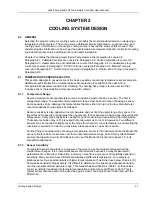
Lake Shore Model 332 Temperature Controller User’s Manual
2.1.3 Environmental
Conditions
The experimental environment is also important when choosing a sensor. Environmental factors such
as high vacuum, magnetic field, corrosive chemicals, or even radiation can limit the use of some
types of sensors. Lake Shore has devoted much time to developing sensor packages that withstand
the temperatures, vacuum levels, and bonding materials found in typical cryogenic cooling systems.
Experiments done in magnetic fields are becoming very common. Field dependence of temperature
sensors is an important selection criteria for sensors used in these experiments. This manual briefly
qualifies the field dependence of most common sensors in the specifications (Table 1-2). Detailed
field dependence tables are included in the Lake Shore Temperature Measurement and Control
Catalog. When available, specific data on other environmental factors is also included in the catalog.
2.1.4 Measurement
Accuracy
Temperature measurements have several sources of error that reduce accuracy. Be sure to account
for errors induced by both the sensor and the instrumentation when computing accuracy. The
instrument has measurement error in reading the sensor signal and error in calculating a temperature
using a temperature response curve. Error results from the sensor being compared to a calibration
standard and the temperature response of a sensor will shift with time and with repeated thermal
cycling (from very cold temperatures to room temperature). Instrument and sensor makers specify
these errors but there are things a user can do to maintain good accuracy. For example, choose a
sensor that has good sensitivity in the most critical temperature range, as sensitivity can minimize the
effect of most error sources. Install the sensor properly following guidelines in Paragraph 2.3. Have
the sensor and instrument periodically recalibrated, or in some other way null the time dependent
errors. Use a sensor calibration that is appropriate for the accuracy requirement.
2.1.5 Sensor
Package
Many types of sensors can be purchased in different packages. Some types of sensors can even be
purchased as bare chips (without any package). A sensor package generally determines its size,
thermal and electrical contact to the outside, and sometimes limits temperature range. When different
packages are available for a sensor, the user should consider the mounting surface for the sensor
and how leads will be heat sinked when choosing.
2.2 CALIBRATED
SENSORS
There can sometimes be confusion in the difficult task of choosing the right sensor, getting it calibrated,
translating the calibration data into a temperature response curve that the Model 332 can understand,
then getting the curve loaded into the instrument. Lake Shore provides a variety of calibration and curve
loading services to fit different accuracy requirements and budgets.
2.2.1 Traditional
Calibration
Calibration is done by comparing a sensor with an unknown temperature response to an accepted
standard. Lake Shore temperature standards are traceable to the U.S. National Institute of Standards
and Testing (NIST) or the National Physical Laboratory in Great Britain. These standards allow Lake
Shore to calibrate sensors from 50 mK to above room temperature. Calibrated sensors are more
expensive than uncalibrated sensors of the same type because of the labor and capitol equipment
used in the process.
This type of calibration provides the most accurate temperature sensors available from Lake Shore.
Errors from sensor calibration are usually smaller than the error contributed by the Model 332. The
Lake Shore Temperature Measurement and Control Catalog has complete accuracy specifications for
calibrated sensors.
2-2
Cooling System Design
















































